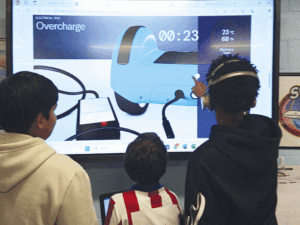MY LEARNING about Xplorlabs began during the STEMaploooza summer conference in my county. A chance to bring real science problems and solutions to my eighth grade physical science students sounded like an opportunity I couldn’t miss.
I was ready and excited to begin with Xplorlabs, then COVID-19 hit. Everything was on hold, including engaging students in authentic science teaching and learning. We scrambled to make science education engaging for the students. Fast forward to 2024, I was ready to start up again and the opportunity for the Xplorlabs Educator Fellowship presented itself!
The students were curious! Fire, heat transfer, lithium-ion batteries, thermal runaway, problems and solutions
We had just finished Xplorlabs’ fire forensics lessons and the students were eager to learn more, so we began Xplorlabs’ Science of Thermal Runaway pathway. As my students watched real lab footage provided by FSRI of the e-mobility device fire and the window blowout, they had so many questions. To better understand their own curiosities, they created a model of their initial ideas in groups and the exploration began — trying to figure out what happened and why.
We explored gas laws, lithium-ion batteries, thermal energy, specific heat capacity, and chemical reactions. The students were engaged in the real-world problem surrounding the e-scooter, lithium-ion batteries, and thermal runaway. As they began to understand what happens with lithium-ion batteries and thermal runaway, it was time to start thinking about a potential solution.
Solving problems through engineering design challenges
Students were able to connect their understanding of lithium-ion batteries and thermal runaway to their everyday lives. They talked to friends and family about thermal runaway, what causes it, and how to avoid it. They checked the chargers in the classrooms and at home, and invited the school secretary to class to learn more. Then, the engineering design challenge began. The goal? Find a way to stop thermal runaway. With their new knowledge, various materials, a couple of hand warmers to simulate battery heat,a plastic container, and some thermometers, they were on their way to developing a solution! In collaborative groups of three to five, students researched materials, developed initial designs, and then built their battery enclosure aimed at preventing thermal runaway. Next, they tested their devices and collected data.
As the students compared data with other groups to see if their device passed the test, the discussions centered around why their device passed or failed “safety standards” for heat management. What materials were used? What was the thermal conductivity and specific heat of the materials? How could they make it better? Most importantly, I frequently heard the question, “why is thermal runaway not a well-known problem?” Students engaged with real experiment data, explored the knowledge to explain it, then engineered solutions all while learning by required standards.
Make learning relevant and engaging for your students!
Check out what Xplorlabs has to offer to change the way we teach and learn science and safety science.
;)


